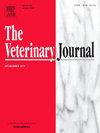Isolation method and characterization of adipocytes as a tool for equine obesity research – In vitro study
IF 3.1
2区 农林科学
Q1 VETERINARY SCIENCES
引用次数: 0
Abstract
Adipose tissue functions as an endocrine organ; however, excessive lipid accumulation can lead to obesity and metabolic disorders, such as Equine Metabolic Syndrome (EMS), characterized by insulin resistance, fat deposition, and increased inflammation. Despite the growing prevalence of obesity in horses, knowledge of equine adipocytes and their metabolic functions remains limited. The main objective of the study was to develop and optimize a method for isolating equine adipocytes and to characterize their metabolic activity. Using slaughterhouse-derived horse visceral adipose tissue, we developed a protocol to isolate mature adipocytes. Metabolic activity of cells was assessed by examining their sensitivity to lipolytic factors: isoproterenol (0.001–10 µM), epinephrine (0.001–1 µM), and forskolin (0.001–1 µM)—and lipogenesis intensity after stimulation with insulin. We obtained mature equine adipocytes with diameters ranging from 50 to 160 µm. These cells demonstrated full metabolic functionality, responding to lipolytic factors such as isoproterenol (all doses: p < 0.001), epinephrine (0.01 µM: p < 0.05; 0.1–1 µM: p < 0.0001), and forskolin (0.001 µM: p < 0.0001). The adipocytes also responded to insulin from all tested species, with effects being dose- and time-dependent (after 2 h human insulin 10 nM, p < 0.05; bovine 10, 100 nM p < 0.05 and after 8 h all doses p < 0.05). The presented method for isolating mature equine adipocytes is effective, yielding metabolically functional cells, which can serve as a valuable in vitro model for studying the effects of various factors on adipocyte function, contributing to a better understanding of equine adipose tissue dysfunction, particularly in the context of metabolic disorders.
作为马肥胖研究工具的脂肪细胞的分离方法和特性-体外研究
脂肪组织具有内分泌功能;然而,过度的脂质积累会导致肥胖和代谢紊乱,如马代谢综合征(EMS),其特征是胰岛素抵抗、脂肪沉积和炎症增加。尽管马的肥胖越来越普遍,但对马脂肪细胞及其代谢功能的了解仍然有限。本研究的主要目的是开发和优化一种分离马脂肪细胞的方法,并表征其代谢活性。使用屠宰场衍生的马内脏脂肪组织,我们制定了分离成熟脂肪细胞的方案。通过检测细胞对脂溶因子(异丙肾上腺素(0.001-10 µM)、肾上腺素(0.001-1 µM)和福斯可林(0.001 - µM)的敏感性和胰岛素刺激后的脂肪生成强度来评估细胞的代谢活性。我们获得了直径在50到160 µm之间的成熟马脂肪细胞。这些细胞表现出充分的代谢功能,对溶脂因子如异丙肾上腺素(所有剂量:p <; 0.001)、肾上腺素(0.01 µM: p <; 0.05;0.1 - 1 µM: p & lt; 0.0001),和forskolin( 0.001µM: p & lt; 0.0001)。脂肪细胞也对来自所有测试物种的胰岛素有反应,其作用是剂量和时间依赖的(2 h后,人胰岛素10 nM, p <; 0.05;牛10,100 nM p <; 0.05,8 h后所有剂量p <; 0.05)。本文提出的分离成熟马脂肪细胞的方法是有效的,可以获得具有代谢功能的细胞,这可以作为研究各种因素对脂肪细胞功能影响的有价值的体外模型,有助于更好地了解马脂肪组织功能障碍,特别是在代谢紊乱的背景下。
本文章由计算机程序翻译,如有差异,请以英文原文为准。
求助全文
约1分钟内获得全文
求助全文
来源期刊

Veterinary journal
农林科学-兽医学
CiteScore
4.10
自引率
4.50%
发文量
79
审稿时长
40 days
期刊介绍:
The Veterinary Journal (established 1875) publishes worldwide contributions on all aspects of veterinary science and its related subjects. It provides regular book reviews and a short communications section. The journal regularly commissions topical reviews and commentaries on features of major importance. Research areas include infectious diseases, applied biochemistry, parasitology, endocrinology, microbiology, immunology, pathology, pharmacology, physiology, molecular biology, immunogenetics, surgery, ophthalmology, dermatology and oncology.
 求助内容:
求助内容: 应助结果提醒方式:
应助结果提醒方式:


